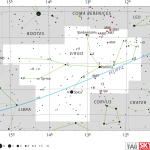Virgo
Exploring Virgo: The Maiden of the Night Sky
As spring approaches, one of the most fascinating constellations takes center stage in the night sky—Virgo, the Maiden. Virgo is one of the largest constellations, second only to Hydra, and holds a special place in both mythology and astronomy. It is home to one of the most intriguing deep-sky objects in the universe: the Virgo Cluster of galaxies. Whether you’re a beginner or an experienced stargazer, Virgo has something to offer.
Finding Virgo in the Sky
Virgo is best seen in the late winter and spring months, reaching its highest point in the sky around April and May. It is a zodiac constellation, meaning the Sun, Moon, and planets occasionally pass through it. To locate Virgo, start with the bright and unmistakable star Arcturus in the constellation Boötes. Following the curve of the Big Dipper’s handle, you can “arc to Arcturus” and then “speed on to Spica,” Virgo’s brightest star. Spica, a blue-white giant, shines at magnitude 1.0 and is one of the most luminous stars in our night sky.
The Virgo Cluster – A Deep-Sky Wonderland
One of Virgo’s greatest attractions is the Virgo Cluster, a vast collection of over 1,300 galaxies located about 54 million light-years away. This cluster is part of the even larger Virgo Supercluster, which includes our own Milky Way. If you have a telescope, try finding M87, a giant elliptical galaxy with a supermassive black hole at its core. This black hole made history in 2019 when astronomers released the first-ever image of a black hole’s event horizon.
Another must-see is M104, the Sombrero Galaxy, which lies on Virgo’s border with Corvus. Its distinct dusty ring and bright central bulge give it the appearance of a wide-brimmed hat. Even a small telescope can reveal its shape, while larger scopes will bring out more detail in its dusty disk.
Virgo in Mythology
Virgo is often associated with fertility and agriculture, linked to goddesses such as Demeter, Persephone, and Astraea in Greek mythology. Some myths suggest that Virgo represents the last of the immortals who left Earth when humanity fell into corruption, reinforcing her connection to purity and justice.
Observing Tips
If you’re looking to explore Virgo, choose a dark sky location away from city lights. Binoculars can help you locate bright galaxies like M87 and M104, but a telescope will reveal much more detail. Patience is key when searching for faint objects—allow your eyes to adjust and use averted vision to detect dimmer galaxies.
Virgo is a treasure trove for amateur astronomers. Whether you’re drawn to its mythology, its bright star Spica, or its deep-sky wonders, this constellation is well worth your time under the stars. Happy stargazing!

